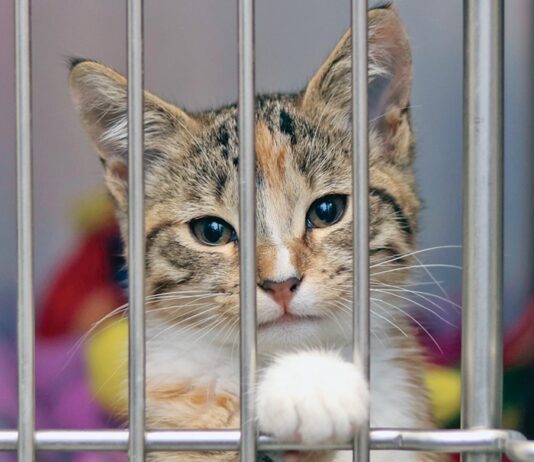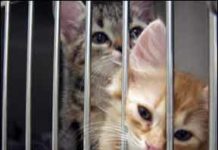Finding Forever Homes at End of Their Journey
The Louisiana SPCA has found a novel solution to overpopulation at its New Orleans shelter. It sends dogs and cats to partner shelters miles away, where they can often be more quickly adopted. Its service is part of a small but growing trend in U.S. shelters and rescue organizations to save animals lives and find them forever homes.
Ask Elizabeth: April 2015
I recently fostered a rescue dog I was told had eaten the feces of a feral cat while being housed in another foster home. This cat subsequently had his stool tested, and it came back positive for toxoplasma gondii. The dog unfortunately defecated in my car while I was transporting him and I am concerned that I may have been exposed to toxoplasma while cleaning up the mess in my car. Do I need to worry about this?
In The News: March 2015
Animal shelters in the U.S. take in 3.4 million cats annually and euthanize 1.3 million of them. Two shelter medicine programs have set out to save many of those lives with the launch of the Million Cat Challenge.The Koret Shelter Medicine Program at UC Davis, Maddies Shelter Medicine Program at the University of Florida and hundreds of animal shelters throughout North America want to challenge animal control facilities and private shelters to reduce euthanasia.
Theyre Giving Kittens a Chance at Life
Of all the animals in shelters, young kittens are usually the most at risk. Theyre fragile, prone to infectious illnesses and have special care needs. While some are placed in foster homes to be hand-raised until they are old enough for adoption, many shelters euthanize them as soon as they are brought in because they dont have the infrastructure or staff to care for them.
Five Reasons For The Behavior And The Techniques To Control It
Once physical and medical causes are ruled out, you may wish to consider some behavioral techniques to curb your cats excessive meowing. First, its important to determine the cause:
Ask Elizabeth: November 2014
Q. Our year-old male cat, found at a county animal shelter seven months ago, has been diagnosed with eosinophilic granuloma complex (EGC). His symptoms are incessant scratching, puffy gums, blistering mouth, swollen front paw, lameness, limping. Our veterinarian has prescribed steroids for him, and these have been somewhat helpful, but can you explain this disease so that we can better understand what is going on? …
Study Puts Feral Cats in the Spotlight
A study published earlier this year that found free-ranging cats annually kill an estimated 2.4 billion birds and more than 20 million mammals drew heated responses from both wildlife and cat advocates.Lost in the controversy was the plight of outdoor cats themselves. They suffer from exposure to extreme weather and more injuries caused by cars, dogs, other cats and wild animals than those who live indoors, says Bruce G. Kornreich, DVM, Ph.D., Associate Director for Education and Outreach at the Feline Health Center at the Cornell University College of Veterinary Medicine.
When You Want to Adopt a Stray
Your next cat may show up when you least expect it. You glance out the window and see a skinny cat with a dirt-smudged coat looking back at you. He doesn’t rush to greet you like a lovable, lost Labrador Retriever. He sizes you up, determining if you’re friend or foe. You place bowls of food and water on the back porch to prevent him from starving or becoming dehydrated, but as the days pass and the cat moves closer to you and lets you pet him, you’re smitten. You’ve made the transition from performing an act of kindness to wanting to provide a safe, loving home.
A Commitment to Improving Well-being
Imagine veterinarians being able to sterilize feral cats by vaccination instead of surgery. Or to identify the connection between a relatively benign form of feline coronavirus and feline infectious peritonitis, which is nearly always fatal, with the hope of finding ways to diagnose and combat it. Or discover how and why vaccine-associated sarcomas may trigger DNA damage in some cats and how this damage may be used to predict which cases of the sarcomas are amenable to chemotherapy. These are just three of the many scientific studies funded by the Cornell Feline Health Center where, under the guidance of Director Colin Parrish, Ph.D., Professor of Virology, the goal of bettering the health of cats continues to be the focus and commitment, as it has been since the center opened its doors in 1974.
Ask Elizabeth: April 2012
Dear Elizabeth: Last summer, my husband and I became the proud keepers of Miss Looci, a four-week-old rescue cat. She’s a lovely, strictly indoor cat — long-haired and pure black. Since she’s been with us, Looci has become my home-bound husband’s constant companion, and she’s become quite big and strong. We love her, and she gets plenty of attention. But here’s our problem: Looci has the habit of suddenly biting me, my husband or our guests while she’s being petted. Why does she do this, and how can we stop her?
Short Takes: February 2012
In shelter and rescue situations, it is extremely important for personnel to identify the most adoptable animals whose adoptions are unlikely to be delayed for medical reasons. This study (“Risk factors for delays between intake and veterinary approval for adoption on medical grounds in shelter puppies and kittens,” in Preventive Veterinary Medicine, 2011) was designed to identify risk factors for health-related delays from intake to approval for adoption in shelter puppies and kittens.
Ask Elizabeth: January 2012
We adopted a new kitten from a local rescue group last month, and she is just perfect. Although she had been tested for the feline leukemia virus and FIV by the terrific group that saved her from the street, we took her to our veterinarian right away so that she could be examined before we introduced her to our two older cats. After a clean bill of health, we brought Bunny home, and she has become a well-integrated part of the family. The problem is that before we scheduled her spay surgery, she came into heat. What a scene!
















